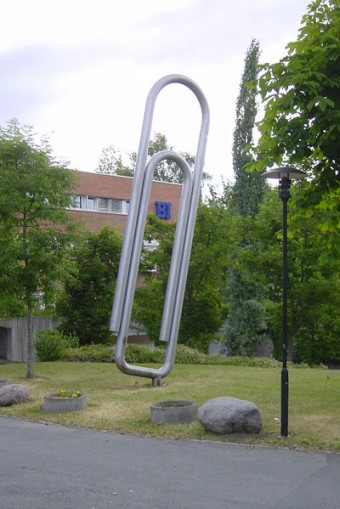The Paperclip was Not Invented by Johan Vaaler
 Myth: The paperclip was invented by Johan Vaaler
Myth: The paperclip was invented by Johan Vaaler
One very popular false origin of the paperclip was that it was invented by Norwegian patent office manager, Johan Vaaler. He was even granted patents in Germany and the U.S. for a paperclip of similar design as the Gem style paperclip, which is the most commonly used paperclip today, but which came after the Gem paperclip was already popular throughout Europe. His design was slightly different than the Gem paperclip in that it didn’t include the all too critical second loop that makes the Gem style much more functional. His paperclip had the papers inserted by lifting the outer wire slightly and pushing the papers into the clip such that the rest of the clip stood out from the paper at a 90 degree angle, which was necessary because of the lack of the critical second loop to allow the papers to be more or less embedded in the clip flatly. This also made it so the papers wouldn’t be held together very well as they relied only on how bendable the wire used was to hold the papers. The Gem style paperclip, on the other hand, exploits the torsion principle to help bind papers together. Vaaler’s design was never manufactured or sold and his patents eventually expired.
Why Vaaler gets the credit in so many places, including in many encyclopedias and dictionaries after the 1950s, is largely thanks to a patent agency worker who was visiting Germany to register Norwegian patents in the 1920s. When he was doing so, he noticed Vaaler’s design for the paperclip and wrote an article stating Vaaler was the original creator of the paperclip.
This misinformation found its way into encyclopedias around the 1950s thanks to WWII. During WWII in Norway particularly, along with France and some other occupied countries, the paperclip became a symbol of unity for those rebelling against the Germans. It is not thought that the Norwegians did this because they thought a Norwegian had invented the paperclip, but rather because it simply signified being bound together and was useful as it wasn’t initially a banned symbol or item by the Germans and could be easily clipped to one’s clothing. Eventually, the Germans caught on and people were prohibited from wearing paperclips.
After the war, the fact that the Gem style paperclip had served as a symbol of unity resulted in interest in the origin of the paperclip, at which point the article written by the patent agency worker and the subsequent patent by Vaaler, who was now long dead, was discovered. It was overlooked, of course, that his design was different than the Gem style paperclip and apparently they didn’t bother checking that the Gem style paperclip had already been around by the time Vaaler patented his version of the paperclip. It made a good story though, particularly after the war and how the paperclip was used in Norway among other places, and so this false origin subsequently found its way into many encyclopedias.
If you liked this article, you might also enjoy our new popular podcast, The BrainFood Show (iTunes, Spotify, Google Play Music, Feed), as well as:
- The Invention Nobody Wanted That Became One of the Top Selling Office Products of All Time
- The Surprisingly Recent Invention of the T-Shirt
- The Microwave Oven Was Invented by Accident by a Man Who was Orphaned and Never Finished Grammar School
- Who Invented the Elevator?
- The Invention of Scotch Tape and Why It is Called That
Bonus Facts:
- Ironically, a Gem style, 23 foot tall paperclip was placed near a university in Oslo in 1989 to honor Vaaler, who in fact had nothing to do with the Gem style paperclip design. Further, a commemorative stamp was created honoring Vaaler that also depicted the Gem style paperclip, not Vaaler’s design.
- The common style of paperclip today was never patented and is known as the “Gem paperclip”. Not surprisingly, it is thought to have first been manufactured by the Gem Manufacturing Company around the 1870s and later introduced to the United States around the 1890s. This is also why the Swedish word for paperclip is “gem”.
- Another false origin of the modern day paperclip often attributes it to Herbert Spencer, who was the man who came up with the term “survival of the fittest”. He claims in his autobiography that he invented a pin that bound papers together. This led to the false belief that he invented the paperclip. In fact, though, his drawing of his binding pin looked more like a cotter pin and, thus, held papers together more like Vaaler’s design. Unlike Vaaler’s design though, this cotter pin style clip wouldn’t stick out nearly as much and, thus, would be more functional than Vaaler’s clip, though not as functional as the Gem style paperclip.
| Share the Knowledge! |
|





good info. but in France they are called Trombones ? They have a similar shape to the brass instrument. were they named after the shape?
So if Vaaler didn’t invent paper clip, who did? I don’t think I saw that in the article
When aliens visited the earth all that they left behind of their advanced technology was paperclips. That is why the origins are so mysterious.